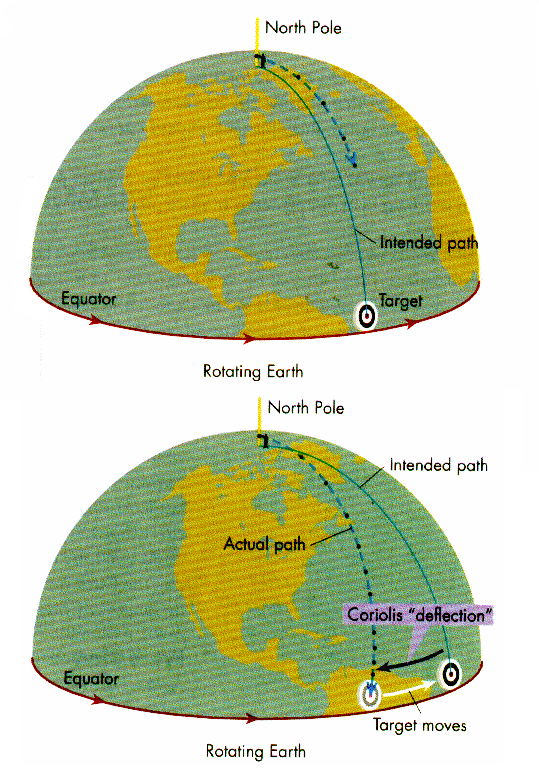Coriolismo (Explanation // Explicación)
(Ver abajo para versión en castellano)
Coriolismo | kɒ.rɪ.ˈɒ.lizːməʊ | is the phenomenon by which the content of a news story is perceived in a different manner from the point of origin. The apparent deflection of meaning is attributed to a distinct perspective, which varies depending on the culture or location of the reader or listener.
If you'd never heard of it, don't worry: it's a new concept.
True to my academic background in Social Sciences (International Relations), I decided to take a scientific term, slap an “ism” on the end and say that it’s a social phenomenon.
The term “coriolismo” comes from the Coriolis effect, which is an “apparent deflection of the path of an object that moves within a rotating coordinate system. The object does not actually deviate from its path, but it appears to do so because of the motion of the coordinate system.”

The Coriolis effect, named after the 19th century mathematician who discovered it, often applies to the Earth’s rotation and particularly, for example, the study of winds and storms. The fun part (in case the rest of this didn’t seem fun for you)? Something that moves along a longitudinal line (i.e. North-South) will suffer an apparent deflection to the right in the Northern Hemisphere, while a similar trajectory in the Southern Hemisphere will undergo an apparent deflection to the left.
Many have questioned the primacy of the Northern hemisphere: why the North is presented as up, why the mapa mundi is clearly biased towards the Northern countries while Southern land masses are often squashed together like a handwritten sentence with too many words on one line. Another starting point for Coriolismo was that curiosity and that criticism: why are we perceiving things in this way? Why not shake things up a little bit?

This is the starting point for the mission of Coriolismo: the recognition of said apparent deflection in journalism, to question it and to compare it to other perspectives.
Every media outlet covers the news in a certain way, everyone knows that: the facts and the characters involved may be the same, but if one compares two different sources it may seem like two different stories. This is especially true when covering different regions and countries: sometimes there is another side of the article, a different perspective or depth that is lacking. This is not only due to a (hopefully healthy) cynicism regarding the way that the news is presented, but can also be attributed to the basic fact that the outlet itself is covering the news from a particular geographic and cultural standpoint.
Coriolismo’s mission is then to recognize and accept this apparent deflection and give the international news a Latin American twist: not to be Latin America centric, that is not the point either, but simply acknowledge that there is a different point of view and to inject a different perspective into the news of the day. Perhaps with a bit of luck the exercise will bring forth new ideas and maybe — just maybe— become incorporated in the reader.
¿Qué es coriolismo?
Coriolismo | kɒ.rɪ.ˈɒ.lizːməʊ | es el fenómeno por el cual el contenido de una noticia se percibe de manera distinta a su punto de origen. La supuesta desviación de su significado se atribuye a una perspectiva distintia, que varía según la ubicación geográfica del lector u oyente.
Si nunca lo habías escuchado, no te preocupes: es un concepto nuevo.
Manteniendome fiel a mi educación en las ciencias sociales (relaciones internacionales), decidí tomar un término científico, ponerle un "ismo" al final y decir que es un fenómeno social.
El término "coriolismo" viene del efecto Coriolismo, lo cual es "una desviación aparente del camino de un objeto que mueve dentro de un sistema rotacional [...] El objeto no se desvía realmente de su camino, pero parece hacerlo por el movimiento del sistema."

El efecto Coriolis, cuyo nombre proviene del matemático que lo descubrió, suele aplicar a la rotación de la Tierra y en particular el estudio de los vientos y tormentas. ¿La parte divertida (por si lo demás no te resultó divertido)? Algo que mueve a lo largo de una línea longitudinal (es decir, de norte a sur) sufrirá una desviación aparente a la derecha en el hemisferio norte mientras que una trayectoria similar en el hemisferio sur atravesarpa una desviación aparente a la izquierda.
Muchos han cuestionado la primacía del hemisferio norte: ¿por qué el norte se presenta como arriba? ¿por qué los mapa mundis son sesgados hacia los países del norte mientras que los países del sur se ven aplastados debajo? Otro punto de partida para Coriolismo fue esa curiosidad y esa crítica: ¿por qué percibimos las cosas de esa manera? ¿Por qué no cambiar las cosas un poco?

Esto es el punto de partida para la misión de Coriolismo: el reconocimiento de dicha desviación aparente en el periodismo, cuestionarla y compararla con otras perspectivas.
Todo medio de comunicación cubre las noticias de cierta manera, todos saben eso: los hechos y los personajes involucrados pueden ser los mismos, pero si uno compara dos fuentes distintos podría parecer dos historias distintas. Esto aplica especialmente cuando se cubren varias regiones y países: a veces hay otro lado del artículo, una perspectiva o una profundidad carente. Esto no proviene sólo de un cinismo (sano, espero) en cuanto a la manera en que la noticia es presentada, pero también del hecho básico de que el medio en sí cubre las noticias desde una perspectiva geográfica y cultural.
La misión de Coriolismo, entonces, es reconocer y aceptar esta desviación aparente y darles un giro latinoamericano a las noticias internacionales: no ser latinoamericano-céntrico, no es la idea tampoco, pero simplemente reconocer que existe otro punto de vista e inyectarle una perspectiva distinta a la noticia del día. Quizás con algo de suerte el ejercicio traerá nuevas ideas y — quizás— volverse un hábito del lector.


















